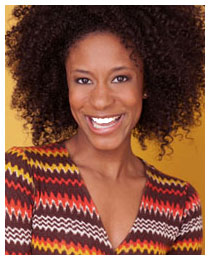Today we kick off the 9th annual tour of the The MLK Project: The Fight for Civil Rights with a free performance for all at the Chicago History Museum! For an inside perspective, here’s a conversation between Director of Education Nicole Ripley and performer Caren Blackmore:

1. Nicole Ripley: Caren this is your third year performing in The MLK Project. Will you talk a little bit about what draws you to this project?
Caren Blackmore: I find Martin Luther King Jr.’s legacy inspiring and empowering and I love being able to keep history relevant to the present. I also believe in education through the arts and this show uses theatre, rap, and video together in order to reach students. I love how this show invites the audience in to Alaya’s experience.
2. NR: In the play, the character Alaya meets many local heroes, both well-known and lesser-known, of the Civil Rights Movement. Since this is a one-person show, you have the challenging job of transforming yourself into so many different characters. How have you tackled this?
CB: The first thing I did was study. I learned each person’s story in order to understand their perspective. I watched videos of each character again and again to identify their mannerisms dialects, word phrasings, habits and details that revealed the essence of who they are. Transforming between the characters is sort of like dance and I had to figure out how one gesture leads into another. The director Jimmy helped me shape and fine-tune each character.
3. NR: You mention working under Jimmy McDermott’s direction. In theatre, the actor, director and designers work together to tell the story. Can you say anything about how this process worked in rehearsal?
CB: Our designers worked closely with the director and I to create the world of the play. The research and design behind Alaya’s costumes inform my character, for example. The video and sound are particularly important in this show and we worked with them throughout the rehearsal process.
4. NR: One of those messages is that Alaya realizes she has to use her mind and her art instead of her fists in order to reach her dreams. How and when did you know you wanted to be a professional actor? What did you need to do, or keep in mind, in order to achieve your goals?
CB: I realized that I wanted to be an actor when I was 17. At first, this was something my family didn’t expect or necessarily understand but theatre was my passion and I committed to pursuing it. To this day it’s still exciting and fresh for me, whether I am in a play, seeing live theatre, helping put up a show, or talking about the art. My path requires hard work and persistence.
5. NR: What has been the biggest challenge working on The MLK Project?
CB: The biggest challenge was incorporating the props – it’s an intricate process. At first my brain said, “You want me to say thousands of lines, transform into seven different people, rap, remember blocking, and pull out props so that the audience doesn’t even notice? Yeah right!” In rehearsal I would drop props, forget them, get them stuck- all kinds of things. When it’s done right, it looks really simple but there is a science to making them appear and disappear smoothly.
6. NR: Yes, that seems like a particular challenge in this one-person play. As a professional actor you have been in many kinds of productions. What is your favorite kind of play to work on?
CB: I really like theatre that experiments – shows that allow the audience to participate and the actors to break the “fourth wall.” This project fits that description!
7. NR: What has been your favorite thing working on The MLK Project?
CB: I really enjoy the post-show discussions. These conversations give young people a platform to reflect and express their experience with the play. Students discussing and exploring solutions to issues raised in the play is inspiring to witness and engage with.
8. NR: Have you learned anything new while working on The MLK Project?
CB: I learned many details about what happened during the Civil Rights Movement. For example, there is so much important history and details in events like the March to Selma and Freedom Summer. It’s also exciting to hear from students about what intrigues them in this history and hear the connections they make to society and their own lives.
9. NR: Do you have any message you’d like to leave with the students who see The MLK Project?
CB: I want students to understand that for anything you need to do, you can start with what you already have. That’s what Alaya does. She doesn’t have money, power, popularity, or connections. She just uses what’s around her and her inner-strength to move forward. Talk to people who inspire you or research them, lean into the things that bring you joy, and stand up for what you know is right.
More on The MLK Project: The Fight for Civil Rights:
Artists | Articles | Videos | Tour Info.


No comments yet.